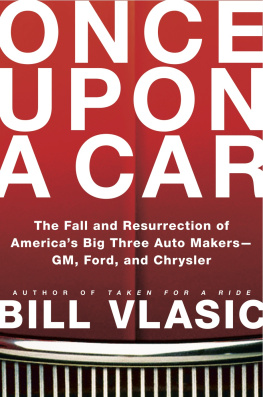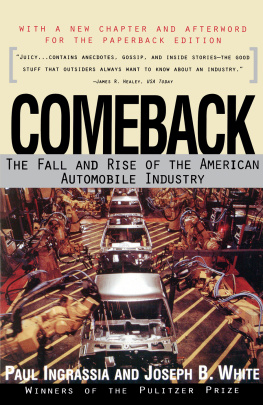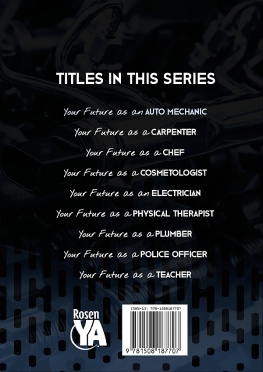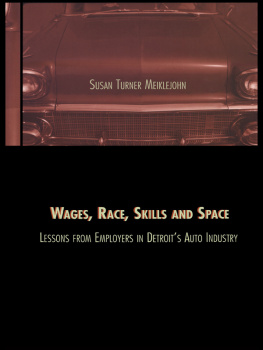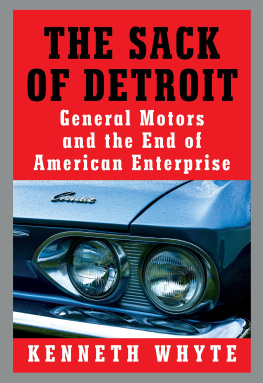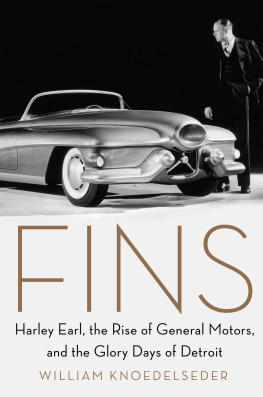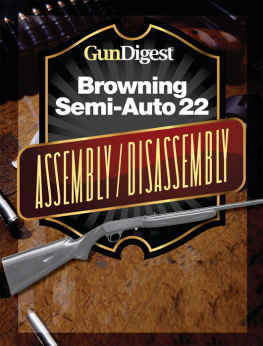Once Upon a Car
The Fall and Resurrection of Americas Big
Three AutomakersGM, Ford, and Chrysler
Bill Vlasic

For my parents, Robert and Nancy Vlasic
Contents
L arry Buhl had been planning this rendezvous for months, and today was finally the day.
It was the second week in January, and the 2005 North American International Auto Show was in full swing in downtown Detroit. The Cobo Center convention floor, bigger than a dozen football fields, was a mass of people roaming like herds among the exhibits of the worlds biggest automakers. The elaborate displays of the hometown giants, General Motors and Ford, owned one side of the hall. The German luxury brands Mercedes-Benz and BMW anchored the other end.
And somewhere in the middle was the man Buhl was looking for.
He walked along the carpeted paths between the million-dollar show stands, each one reflecting the company behind itsleek and futuristic at Honda and Nissan, lots of chrome and bright colors at Dodge and Chrysler, stark backdrops and pretty women in slinky dresses at Ferrari and Lamborghini. Cars of every size and shape were bathed in bright spotlights, polished and posed for the hordes of journalists and camera crews and auto executives that swarmed around the hall.
Buhl felt right at home. He lived in Connecticut but had grown up just down the road in Grosse Pointe, Michigan. He had been going to the show for years. It was like an extension of the holidays in DetroitChristmas, New Years, auto show. It was also the perfect place to blend into a crowd and meet someone unnoticed. Buhl crossed the convention floor, took a turn behind the man-made mountain with a Jeep hanging off it, made a left at the Toyota exhibit, and spied the smallest, plainest stand in the entire placethree quirky little cars surrounded by college-age sales reps in polo shirts and khakis. And there, working by the red Scion sign, was Jim Farley.
Since last summer, Buhl had been trying to set up a meeting between Farley, a rising executive at Toyota and head of its new Scion division, and one of Buhls oldest friends, William Clay Ford Jr., the chairman and chief executive officer of the Ford Motor Company. The idea came to Buhl during a conversation with Farleys father on a golf course in northern Michigan, where the Farley and Buhl families had owned vacation homes for years. Something struck me when I saw Jims dad, Buhl recalled. I thought Ford could really use a guy like Jim.
Larry Buhl had known Bill Ford since they were kids. They went to private schools together, played the same sports, socialized throughout college, and stayed close into their mid-forties. One went on to become a successful entrepreneur buying and selling specialty metals on the East Coast. The other became the leader of the second-biggest car company in the world.
Buhl cherished their bond, but lately he had been worried about his friend. He saw what the pressure of running the Ford Motor Company, his familys business for more than a hundred years, was doing to Bill. Executives came and went at Ford headquarters, but none of them was able to help Bill stave off the flood of Toyotas, Hondas, and other foreign cars that were relentlessly beating Ford in the market. Buhl saw Bills spirits sag when they talked about it. Its too much for you, he kept telling him. How can you shoulder all of this responsibility yourself?
What Ford needed was fresh blood. Buhl would never be so presumptuous as to suggest to Bill that he hire Jim Farley. But if he could get the two of them together, who knew what might happen? When he brought it up, Bill said sure, he was open to it. It was a little trickier to convince Farley. Buhls brother Robbie, a professional race car driver and fellow car fanatic, had been tight with Farley for years. Still, when Buhl called Farley, he was cool to the idea of sitting down with anyone at one of Toyotas biggest competitors.
Im not interested in going anyplace, Farley said. Im really happy at Toyota.
Come on, Buhl said. Im just talking about introducing you to a friend of mine.
I dont feel comfortable about this, Farley said. Things are going so well for us, and for me.
You have to meet him, Buhl said.
Why?
Because, Buhl said, its good for you.
Now as he walked toward the Scion stand, Buhl still didnt know if Farley would ever consider leaving Toyota. What he did know was that Jim Farley could sell cars as well as anyone on the planet.
And he was proving it every day. In just two years, Farley had grown Toyotas new Scion brand, created specifically for younger buyers, from zero sales in the United States to 100,000 vehicles a year. His bosses in Japan and in Los Angeles had entrusted him to somehow make bland and reliable Toyota hip, and he embraced the challenge. Farley took Scion cars to rock concerts, street festivals, and college campusesanywhere that Generation Y hung out. He was constantly on the road, setting up Scion showrooms inside existing Toyota dealerships, and making them cool, pressure-free boutiques for these interesting little Japanese cars with funky designs and small engines.
Farley inhabited the job completelyhanging out with twentysomething trendsetters on the coasts, learning why they chose their favorite products, from computers to clothes to cars. You need to love your customer, feel their joy, understand their pain, he said. You have to get so close to them you can smell their breath.
But as sensitive and idealistic as he sounded, Farley had an edge to him. Other automakers were the enemy vying for the same turf, and Farley would never give an inch. When he heard that Bob Lutz, the vice chairman of General Motors, had called the shoebox-shaped Scion xB weird-looking, those were fighting words. I could care less about Detroit, Farley said. Give me a break. Detroit got its ass kicked trying to market to kids.
At the Scion stand, Farley was in his elementchatting up reporters, showing off the cars, greeting visitors. With a mop of brown hair flopped over his forehead and wearing a suit that looked just a size too big, Farley seemed younger than his forty-two years. He also was having way more fun than the buttoned-down, deadly serious executives holding court at the other displays. The media flocked to him, and he rarely disappointed. He was provocative, blunt, and unafraid to criticize an older generations view of todays young consumer. These kids are not Camaro buyers from the seventies being reincarnated, he said. These people are sharp. They have higher expectations. He said it all with a mischievous smile that called to mind his late cousin, the comedian Chris Farley of Saturday Night Live fame. He even sounded like Chris, especially when he laughed.
When he saw Buhl walking up, Farley greeted him warmly, like the old family friend he was. They walked across the convention floor together and into the busy hallway dominated by a big bronze statue of the boxer Joe Louis, the embodiment of Motor City muscle. The second they entered the parking garage, Farley started shivering, the bitter chill of January in Detroit a reality check for a guy who lived and worked in Southern California. They hustled to Buhls car and headed out onto Michigan Avenue, six lanes of blacktop bisecting some of the citys bleakest neighborhoods, and into the adjoining community of Dearborn, the home of the Ford Motor Company.
Farley was quiet as they passed the falafel joints, strip clubs, and discount stores that lined the wide avenue. In the distance he could see the belching smokestacks of Fords famous Rouge assembly complex, stretching more than a mile long and wide, with dozens of factories, some dating back to the 1920s. The heavy gray cloud cover seemed to sit on top of the buildings, and everything looked frozen solid. Im from Santa Monica, I work in Torrance, I go to Toyota City in Japan, Farley said to himself. Thats my auto industry. This is just so... old.
Next page
